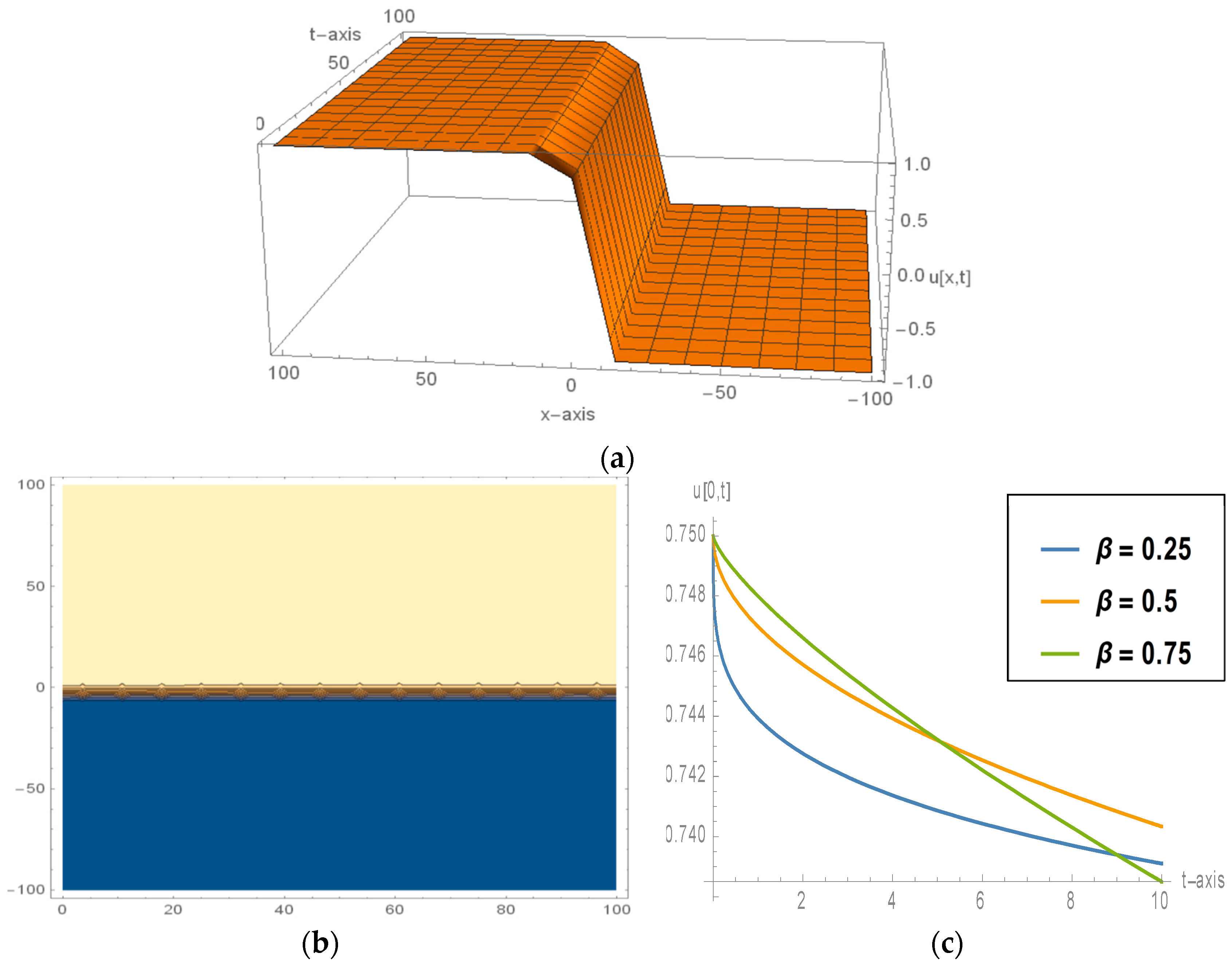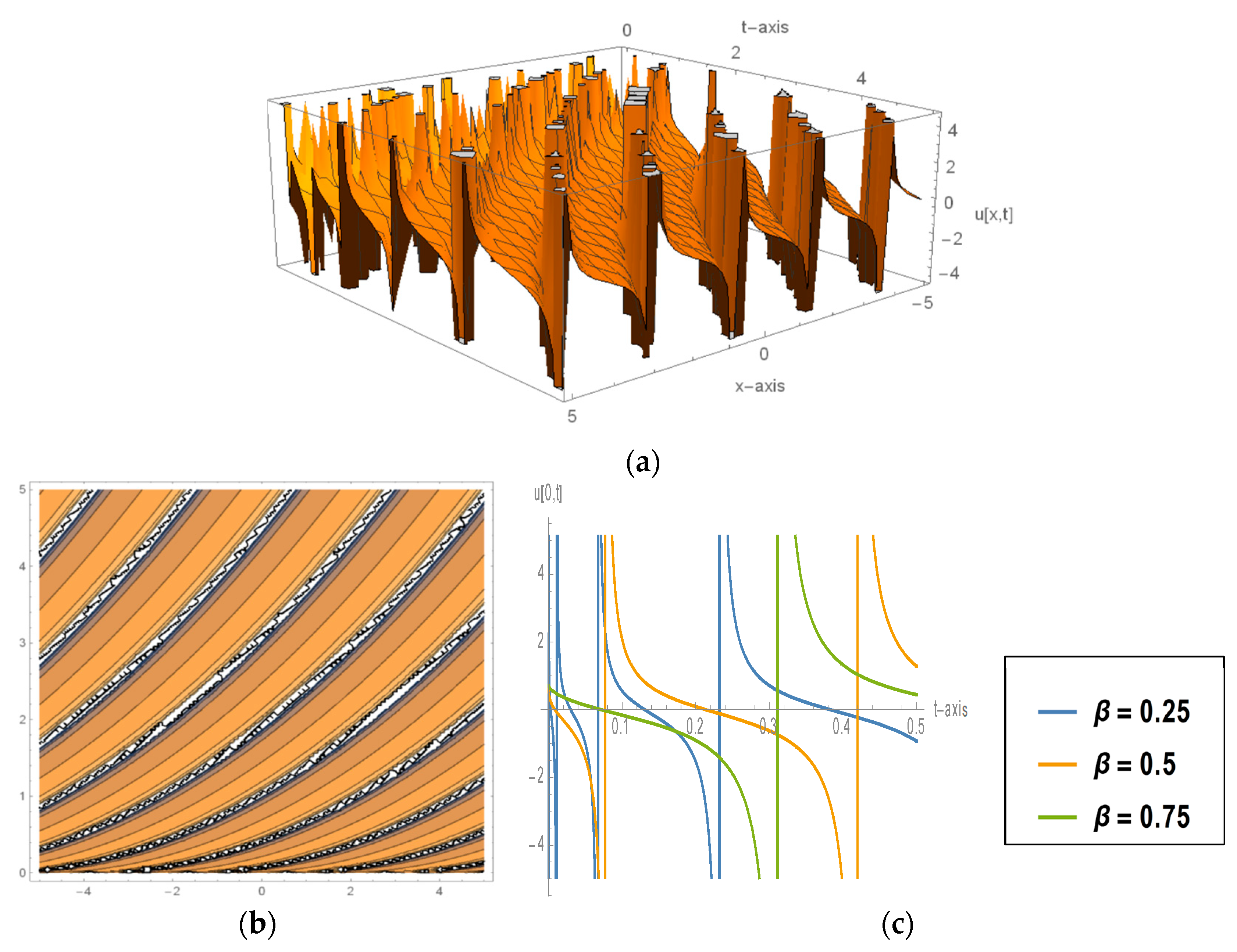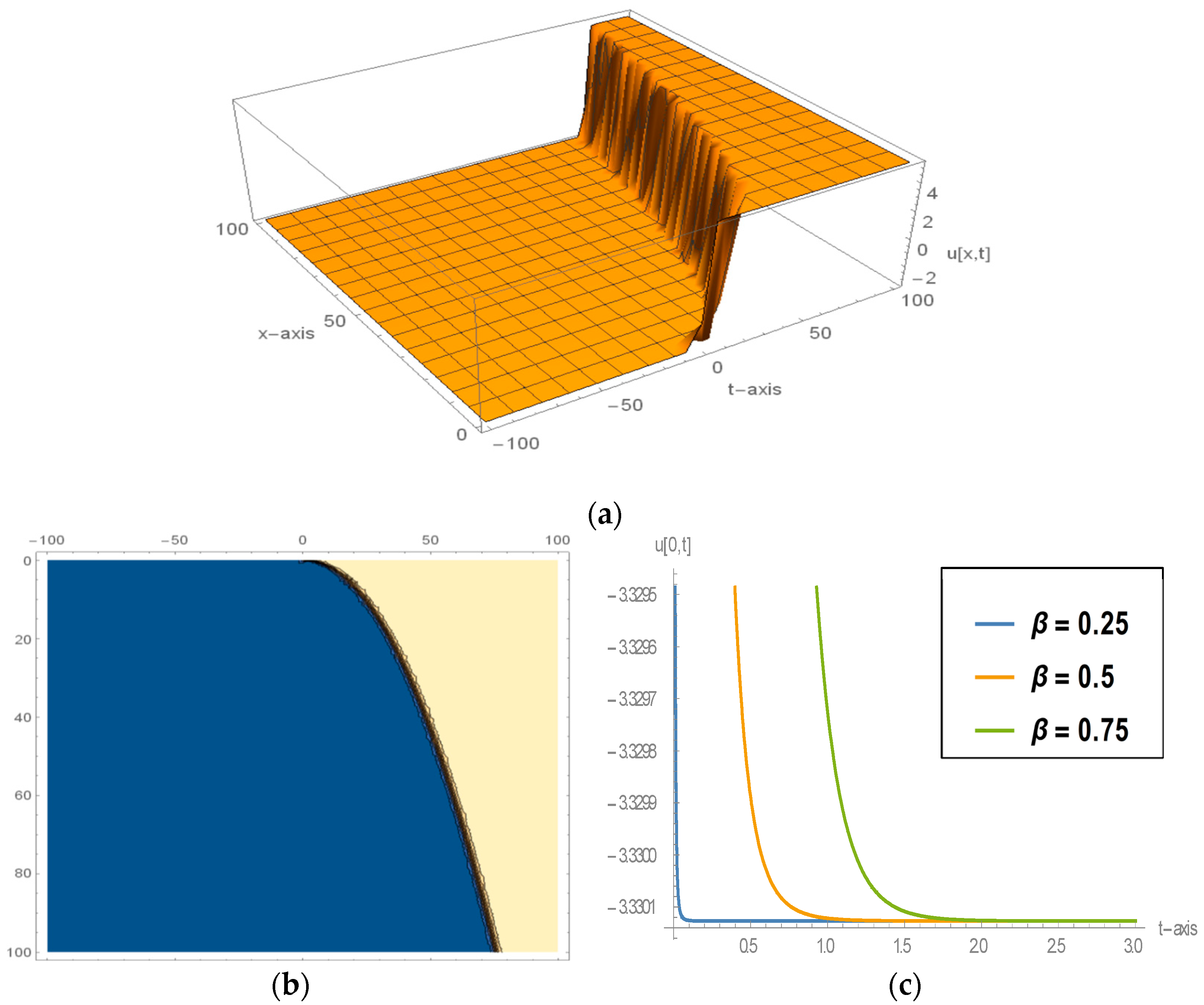Extracting the Ultimate New Soliton Solutions of Some Nonlinear Time Fractional PDEs via the Conformable Fractional Derivative
Abstract
1. Introduction
- -
- -
2. Definition of Conformable Fractional Derivative and Its Characteristics
- (vii)
- If and are -differentiable function of in the domain and then,
3. Discussion of the Expansion Method
4. Applications and Discussions
4.1. Investigation of the KGE
4.2. Investigation of the STOE
4.3. Investigation of the CRWPE
5. Interpretation of the Numerical Outputs along with Their Graphical Portraiture
6. Comparison of the Results
7. Conclusions
Author Contributions
Funding
Data Availability Statement
Conflicts of Interest
References
- Tariq, K.U.; Younis, M.; Rezazadeh, H.; Rizvi, S.T.R.; Osman, M.S. Optical solitons with quadratic–cubic nonlinearity and fractional temporal evolution. Mod. Phys. Lett. B 2018, 32, 1850317. [Google Scholar] [CrossRef]
- Partohaghighi, M.; Akgül, A.; Alqahtani, R.T. New type modelling of the circumscribed self-excited spherical attractor. Mathematics 2022, 10, 732. [Google Scholar] [CrossRef]
- Partohaghighi, M.; Akgül, A.; Guran, L.; Bota, M.F. Novel mathematical modelling of platelet-poor plasma arising in a blood coagulation system with the fractional Caputo-Fabrizio derivative. Symmetry 2022, 14, 1128. [Google Scholar] [CrossRef]
- Kumar, P.; Baleanu, D.; Erturk, V.S.; Inc, M.; Govindaraj, V. A delayed plant disease model with Caputo fractional derivatives. Adv. Contin. Discret. Models 2022, 1, 11. [Google Scholar] [CrossRef]
- Ahmad, S.; Ullah, A.; Abdeljawad, T.; Akgül, A.; Mlaiki, N. Analysis of fractal-fractional model of tumor-immune interaction. Results Phys. 2021, 25, 104178. [Google Scholar] [CrossRef]
- Alaroud, M.; Alomari, A.-K.; Tahat, N.; Ishak, A. Analytical computational scheme for multivariate nonlinear time-fractional generalized biological population model. Fractal Fract. 2023, 7, 176. [Google Scholar] [CrossRef]
- Ali, K.K.; El Salam, M.A.A.; Mohamed, E.M.H.; Samet, B.; Kumar, S.; Osman, M.S. Numerical solution for generalized nonlinear fractional integro-differential equations with linear functional arguments using Chebyshev series. Adv. Differ. Equ. 2020, 2020, 494. [Google Scholar]
- Atangana, A.; Baleanu, D. New fractional derivatives with nonlocal and non-singular kernel: Theory and application to heat transfer model. J. Therm. Sci. 2016, 20, 763–769. [Google Scholar] [CrossRef]
- Caputo, M.; Fabrizio, M. A new definition of fractional derivative without singular kernel. Prog. Fract. Differ. Appl. 2015, 1, 73–85. [Google Scholar]
- Abdon, A. Fractal-fractional differentiation and integration: Connecting fractal calculus and fractional calculus to predict complex system. Chaos Solitons Fractals 2017, 102, 396–406. [Google Scholar]
- Yang, X.; Wu, L.; Zhang, H. A space-time spectral order sine-collocation method for the fourth-order nonlocal heat model arising in viscoelasticity. Appl. Math. Comput. 2023, 457, 128192. [Google Scholar]
- Jiang, X.; Wang, J.; Wang, W.; Zhang, H. A predictor-corrector compact difference scheme for a nonlinear fractional differential equation. Fractal Fract. 2023, 7, 521. [Google Scholar] [CrossRef]
- Turut, V.; Güzel, N. On solving partial differential equations of fractional order by using the variational iteration method and multivariate Padé approximations. Eur. J. Pure Appl. Math. 2013, 6, 147–171. [Google Scholar]
- Rahman, R.U.; Qousini, M.M.M.; Alshehri, A.; Eldin, S.M.; El-Rashidy, K.; Osman, M. Evaluation of the performance of fractional evolution equations based on fractional operators and sensitivity assessment. Results Phys. 2023, 49, 106537. [Google Scholar] [CrossRef]
- Bravo, J.; Lizama, C. The abstract Cauchy problem with Caputo-Fabrizio fractional derivative. Mathematics 2022, 10, 3540. [Google Scholar] [CrossRef]
- Yépez-Martínez, H.; Gómez-Aguilar, J. A new modified definition of Caputo-Fabrizio fractional-order derivative and their applications to the multi-step homotopy analysis method (MHAM). J. Comput. Appl. Math. 2019, 346, 247–260. [Google Scholar] [CrossRef]
- Labade, M.B. An overview of definitions of Riemann-Liouville’s fractional derivative and Caputo’s fractional derivative. Int. J. Sci. Res. IJSR 2021, 10, 1210–1212. [Google Scholar]
- Owolabi, K.M. Riemann-Liouville fractional derivative and application to model chaotic differential equations. Prog. Fract. Differ. Appl. 2018, 4, 99–110. [Google Scholar] [CrossRef]
- Murshed, R. Conformable fractional derivatives and it’s applications for solving fractional differential equations. IOSR J. Math. 2017, 13, 81–87. [Google Scholar]
- Lascano, V.; Cortez, M.V. Khalil conformable fractional derivative and its applications to population growth and body cooling models. Sel. Matemática 2022, 9, 44–52. [Google Scholar] [CrossRef]
- Partohaghighi, M.; Mirtalebi, Z.; Akgül, A.; Riaz, M.B. Fractal-fractional Klein-Gordon equation: A numerical study. Results Phys. 2022, 42, 105970. [Google Scholar] [CrossRef]
- Rezazadeh, H.; Khodadad, F.S.; Manafian, J. New structure for exact solutions of nonlinear time fractional Sharma-Tasso-Olver equation via conformable fractional derivative. Appl. Appl. Math. Int. J. AAM 2017, 12, 405–414. [Google Scholar]
- Kupershmidt, B.A. Dark equations. J. Nonlinear Math. Phys. 2001, 8, 363–445. [Google Scholar] [CrossRef]
- Seadawy, A.R.; Ali, A.; Raddadi, M.H. Exact and solitary wave solutions of conformable time fractional Clannish Random Walker’s Parabolic and Ablowitz-Kaup-Newell-Segur equations via modified mathematical methods. Results Phys. 2021, 26, 104374. [Google Scholar] [CrossRef]
- Rahman, M.M.; Habib, M.A.; Ali, H.M.S.; Miah, M.M. The generalized Kudryashov method: A renewed mechanism for performing exact solitary wave solutions of some NLEEs. J. Mech. Contin. Math. Sci. 2019, 14, 323–339. [Google Scholar] [CrossRef]
- Kumar, D.; Park, C.; Tamanna, N.; Paul, G.C.; Osman, M.S. Dynamics of two-mode Sawada-Kotera equation: Mathematical and graphical analysis of its dual-wave solutions. Results Phys. 2020, 19, 103581. [Google Scholar] [CrossRef]
- Kumar, A.; Kumar, D.S.; Singh, M. Residual power series method for fractional Sharma-Tasso-Olever equation. Commun. Numer. Analy 2016, 1, 1–10. [Google Scholar] [CrossRef]
- Alaroud, M. Application of Laplace residual power series method for approximate solutions of fractional IVP’s. Alex. Eng. J. 2022, 61, 1585–1595. [Google Scholar] [CrossRef]
- Yaslan, H.C.; Girgin, A. Exp-function method for the conformable space-time fractional STO, ZKBBM and coupled Boussinesq equations. Arab. J. Basic Appl. Sci. 2019, 26, 163–170. [Google Scholar] [CrossRef]
- Zheng, B. Exp-function method for solving fractional partial differential equations. Sci. World J. 2013, 2013, 465723. [Google Scholar] [CrossRef]
- Ismael, H.F.; Bulut, H.; Park, C.; Osman, M.S. M-lump, N-soliton solutions, and the collision phenomena for the (2+1)-dimensional Date-Jimbo-Kashiwara-Miwa equation. Results Phys. 2020, 19, 103329. [Google Scholar] [CrossRef]
- He, J.-H.; Wu, X.-H. Variational iteration method: New development and applications. Comput. Math. Appl. 2007, 54, 881–894. [Google Scholar] [CrossRef]
- Wazwaz, A.M. The variational iteration method for solving linear and nonlinear ODEs and scientific models with variable coefficients. Open Eng. 2014, 4, 64–71. [Google Scholar] [CrossRef]
- Yasmin, H.; Aljahdaly, N.H.; Saeed, A.M.; Shah, R. Investigating families of soliton solutions for the complex structured coupled fractional Biswas-Arshed model in birefringent fibers using a novel analytical technique. Fractal Fract. 2023, 7, 491. [Google Scholar] [CrossRef]
- Majid, S.Z.; Faridi, W.A.; Asjad, M.I.; El-Rahman, M.A.; Eldin, S.M. Explicit soliton structure formation for the Riemann wave equation and a sensitive demonstration. Fractal Fract. 2023, 7, 102. [Google Scholar] [CrossRef]
- Fahim, M.R.A.; Kundu, P.R.; Islam, M.E.; Akbar, M.A.; Osman, M.S. Wave profile analysis of a couple of (3+1)-dimensional nonlinear evolution equations by sine-Gordon expansion approach. J. Ocean. Eng. Sci. 2022, 7, 272–279. [Google Scholar] [CrossRef]
- Varol, D. Solitary and periodic wave solutions of the space-time fractional extended Kawahara equation. Fractal Fract. 2023, 7, 539. [Google Scholar] [CrossRef]
- Rehman, H.U.; Akber, R.; Wazwaz, A.M.; Alshehri, H.M.; Osman, M.S. Analysis of Brownian motion in stochastic Schrödinger wave equation using Sardar sub-equation method. Optik 2023, 289, 171305. [Google Scholar] [CrossRef]
- Iqbal, M.A.; Baleanu, D.; Miah, M.M.; Ali, H.M.S.; Alshehri, H.M.; Osman, M.S. New soliton solutions of the mZK equation and Gerdjikov-Ivanov equation by employing the double (G′/G, 1/G)-expansion method. Results Phys. 2023, 47, 106391. [Google Scholar] [CrossRef]
- Iqbal, M.A.; Wang, Y.; Miah, M.M.; Osman, M.S. Study on Date-Jimbo- Kashiwara-Miwa equation with conformable derivative dependent on time parameter to find the exact dynamic wave solutions. Fractal Fract. 2022, 6, 4. [Google Scholar] [CrossRef]
- Ali, H.M.S.; Habib, M.A.; Miah, M.M.; Akbar, M.A. Solitary wave solutions to some nonlinear fractional evolution equations in mathematical physics. Heliyon 2020, 6, e03727. [Google Scholar] [CrossRef] [PubMed]
- Iqbal, M.; Ashik, M.; Miah, M.; Rasid, M.M.; Alshehri, H.M.; Osman, M.S. An investigation of two integro-differential KP hierarchy equations to find out closed form solitons in mathematical physics. Arab. J. Basic Appl. Sci. 2023, 30, 535–545. [Google Scholar] [CrossRef]
- Hong, B.; Chen, W.; Zhang, S.; Xub, J. The G′/(G′+G+A)-expansion method for two types of nonlinear schrödinger equations. J. Math. Phys. 2019, 31, 1155–1156. [Google Scholar]
- Taghizadeh, N.; Mirzazadeh, M.; Rahimian, M.; Akbari, M. Application of the simplest equation method to sometime-fractional partial differential equations. Ain Shams Eng. J. 2013, 4, 897–902. [Google Scholar] [CrossRef]
- Kashyap, M.; Singh, S.P.; Gupta, S.; Purnima, L. Novel solution for time-fractional Klein-Gordon equation with different applications. Int. J. Math. Eng. Manag. Sci. 2023, 8, 537–546. [Google Scholar] [CrossRef]
- Malagi, N.S.; Veeresha, P.; Prasanna, G.D.; Prasannakumara, B.C.; Prakasha, D.G. Novel approach for nonlinear time-fractional Sharma-Tasso-Olever equation using Elzaki transform. Int. J. Optim. Control. Theor. Appl. 2023, 13, 46–58. [Google Scholar] [CrossRef]
- Sontakke, B.R.; Shaikh, A. Solving time fractional Sharma−Tasso-Olever equation using fractional complex transform with iterative method. Br. J. Math. Comput. Sci. 2016, 19, 1–10. [Google Scholar] [CrossRef]
- Guner, O.; Bekir, A.; Ünsal, Ö. Two reliable methods for solving the time fractional Clannish Random Walker’s Parabolic equation. Optik 2016, 127, 9571–9577. [Google Scholar] [CrossRef]
- Bulut, H.; Kilik, B. Exact solutions for some fractional nonlinear partial differential equations via Kudryashov method. NWSA-Phys. Sci. 2013, 8, 24–31. [Google Scholar]
- Rahimy, M. Applications of fractional differential equations. Appl. Math. Sci. 2010, 4, 2453–2461. [Google Scholar]
- Jadhav, C.; Dale, T.; Dhondge, S. A review on applications of fractional differential equations in engineering domain. Math. Stat. Eng. Appl. 2022, 71, 7147–7166. [Google Scholar]
- Johansyah, M.D.; Supriatna, A.K.; Rusyaman, E.; Saputra, J. Application of fractional differential equation in economic growth model: A systematic review approach. AIMS Math. 2021, 6, 10266–10280. [Google Scholar] [CrossRef]
- Wu, Z.; Zhang, X.; Wang, J.; Zeng, X. Applications of fractional differentiation matrices in solving Caputo fractional differential equations. Fractal Fract. 2023, 7, 374. [Google Scholar] [CrossRef]
- Odibat, Z.; Baleanu, D. On a new modification of the Erdélyi-Kober fractional derivative. Fractal Fract. 2021, 5, 121. [Google Scholar] [CrossRef]
- Khalil, R.; Al Horani, M.; Yousef, A.; Sababheh, M. A new definition of fractional derivative. J. Comput. Appl. Math. 2014, 264, 65–70. [Google Scholar] [CrossRef]
- Abdeljawad, T. On conformable fractional calculus. J. Comput. Appl. Math. 2015, 279, 57–66. [Google Scholar] [CrossRef]
- Eslami, M.; Rezazadeh, H. The first integral method for Wu-Zhang system with conformable time-fractional derivative. Calcolo 2016, 53, 475–485. [Google Scholar] [CrossRef]
- Tian, Q.; Yang, X.; Zhang, H.; Xu, D. An implicit robust numerical scheme with graded meshes for the modified Burgers model with nonlocal dynamic properties. Comput. Appl. Math. 2023, 42, 246. [Google Scholar] [CrossRef]





| Comparison of the obtained results with those of Taghizadeh et al. [44] | |
| Results of Taghizadeh et al. [44] using the simplest equation method on time-fractional KGE | -expansion method |
| , , , , then the result gives exponential function solution as . Again for , , then the result gives hyperbolic function results as . | For , , , ,,, then result gives exponential function solution as . (ii) gives trigonometric function solution as . |
| Comparison of the obtained results with those of Taghizadeh et al. [44] | |
| Results of Taghizadeh et al. [44] using the simplest equation method on time-fractional STOE | -expansion method |
| , , and , then the result gives the exponential function solution as . For , , , , , then the result gives hyperbolic function solution as . | For , , , , , then result gives exponential function solution as , where . (ii) gives trigonometric function solution as , where and . |
| Comparison of the obtained results with the results of Guner et al. [48] | |
| Results of Guner et al. [48] -expansion method on time-fractional CRWPE | -expansion method |
| , , , , , , , and , then gives hyperbolic solution as . gives rational function solution as , where . | For , , , , , then gives exponential function solution as , where . gives trigonometric function solution as where . |
Disclaimer/Publisher’s Note: The statements, opinions and data contained in all publications are solely those of the individual author(s) and contributor(s) and not of MDPI and/or the editor(s). MDPI and/or the editor(s) disclaim responsibility for any injury to people or property resulting from any ideas, methods, instructions or products referred to in the content. |
© 2024 by the authors. Licensee MDPI, Basel, Switzerland. This article is an open access article distributed under the terms and conditions of the Creative Commons Attribution (CC BY) license (https://creativecommons.org/licenses/by/4.0/).
Share and Cite
Iqbal, M.A.; Ganie, A.H.; Miah, M.M.; Osman, M.S. Extracting the Ultimate New Soliton Solutions of Some Nonlinear Time Fractional PDEs via the Conformable Fractional Derivative. Fractal Fract. 2024, 8, 210. https://doi.org/10.3390/fractalfract8040210
Iqbal MA, Ganie AH, Miah MM, Osman MS. Extracting the Ultimate New Soliton Solutions of Some Nonlinear Time Fractional PDEs via the Conformable Fractional Derivative. Fractal and Fractional. 2024; 8(4):210. https://doi.org/10.3390/fractalfract8040210
Chicago/Turabian StyleIqbal, Md Ashik, Abdul Hamid Ganie, Md Mamun Miah, and Mohamed S. Osman. 2024. "Extracting the Ultimate New Soliton Solutions of Some Nonlinear Time Fractional PDEs via the Conformable Fractional Derivative" Fractal and Fractional 8, no. 4: 210. https://doi.org/10.3390/fractalfract8040210
APA StyleIqbal, M. A., Ganie, A. H., Miah, M. M., & Osman, M. S. (2024). Extracting the Ultimate New Soliton Solutions of Some Nonlinear Time Fractional PDEs via the Conformable Fractional Derivative. Fractal and Fractional, 8(4), 210. https://doi.org/10.3390/fractalfract8040210







